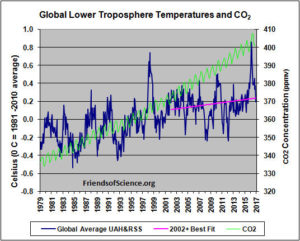by K. Richard, Nov 12, 2024 in NoTricksZone
“[T]he contribution of CO2 to the greenhouse effect is 4% – 5%. Human CO2 emissions represent 4% of the total, which means that the total human contribution to the enhancement of the greenhouse effect is 0.16% to 0.20% – a negligible effect.” – Dr. Demetris Koutsoyiannis (2024)
New research exposes the vacuousness of the “imaginary world” models proclaiming CO2 the dominant regulator of the Earth’s climate.
A CO2-less or CO2-only atmosphere…an imaginary-world thought experiment
An oft-heard claim is that, due to the prominence of CO2 as the Earth’s climate “control knob” (see Lacis et al., 2010), the greenhouse effect could not exist – indeed, it would collapse – if there was no CO2 in the atmosphere.
However, it should go without saying that this CO2-less atmospheric condition itself is an imaginary-world conceptualization. Thus, fantasizing about what would happen if the atmosphere was comprised 0 ppm CO2, 1,000,000 ppm CO2, 0 ppm water vapor…are all just untestable, never-observable thought experiments. They cannot be subjected to the scientific method. Thus, they are unfalsifiable.
CO2’s climate effects are undetectable
Of course, this very unfalsifiable thought experiment is what believers in the CO2-is-the-climate-control-knob narrative rest their case on. But even if we do use this imaginary-world premise, the existing models (MODTRAN, HITRAN) that allegedly support the CO2-controls-climate orthodoxy actually undermine it.
For example, as Dr. Koutsoyiannis points out in his extensively-referenced paper, the MODTRAN data show that the Earth’s temperature remains at the default greenhouse-effect value if the water vapor scale is adjusted upwards slightly, by just 30%. The greenhouse effect does not “collapse” as claimed by Lacis et al. disciples – the control-knob believers.
The HITRAN database also indicates the imaginary-world condition of doubling CO2 from 400 to 800 ppm would only alter the radiation flux at the top of the atmosphere by -1.1%, a hypothetical realization that could not even be detected in future macroscopic measurements (if the atmosphere ever were to reach a CO2 concentration of 800 ppm).
MODTRAN models further affirm that (1) there is only a 1% temperature difference between either doubling (800 ppm) or halving (200 ppm) the atmospheric CO2 concentration, and (2) the change in the downwelling radiation resulting from an increase from 300 ppm (1900) to 420 ppm (2023) is only 0.5%. These tiny changes “could not be discerned by observations.”
…



